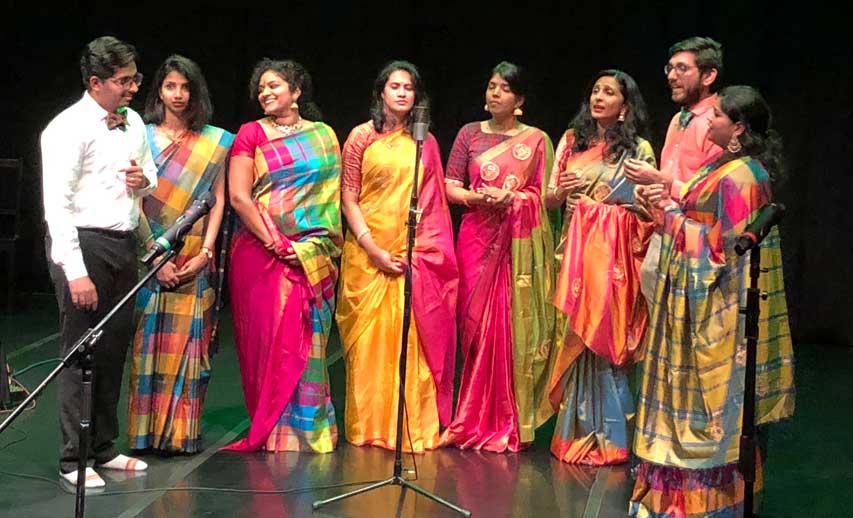Devi Durga Kathak Sansthan presented on 4th and 5th September 2020 two day dance festival featuring Kathak, Bharatanatyam, Odissi dance forms by a galaxy of young exponents.

The opening evening consisted of Kathak by disciples of Guru Smt Geetanjali Lal and Guru Abhimanyu Lal. The prayer in praise of Lord Shiva reverberated with Lord’s Damaru. The two female dancers Varsha Dasgupta and Era Dogra and two male dancers Nikhil and Akshar Tekchandani, in group choreography, evoked the devotional mood. The sound of Damaru with mnemonic syllables was innovatively and imaginatively used.
The iconic image with Ganga flowing from his matted locks, wielding a trident, besmeared with ash, the Panchavadan, Lord of the Ganas, Bhutanath was choreographed with circular movements. Standing behind one artist raising arms, the four-armed image came in sharp focus. The lighting by Nitin Jain highlighted the impact. The choreography and music were by Guru Geetanjali Lal.

Radhika Kathal, a Bharatanatyam disciple of celebrated dancer Geeta Chandran, has carved her own niche with thorough training under her guru. Well versed in Hindustani music and nattuvangam Radhika has commendable anga saushthava. Her Alarippu in tisram explored the four directions in a sitting posture with perfect aramandi. It was a pleasure to see Alarippu performed with such perfection. Of late few dancers perform it. Geeta Chandran’s nattuvangam with complicated rhythmic patterns and Radhika’s pirouettes were noteworthy.
Gopal Krishna Bharati’s kirtana Natanam Adinar, representing Anand Tandava of Lord Shiva in Basanta raga is a de rigour number which dancers master displaying their prowess on tala and laya. The choreography by Geeta Chandran wove in various karanas, including subtle suggestive sanchari of Kamadeva turned into ashes when Lord opened his third eye, were executed by Radhika with aplomb and finesse. The rock steady stand with Dandapada Karana left an indelible impression.
Kevin Vinod Bachhan from Trinidad, currently under training from Odissi exponent Ranjana Gauhar, has matured in recent years. He has also put on little weight which has enhanced his personality. Performing to Mira’s bhajan Jhuki ayi badariya savana ki, in Malhar raga created the ambience of monsoon. In the gathering of dark clouds, Mira saw the image of dark Krishna, the gentle showers of rain, nanhi nanhi bundiya, and neha barse found felicitous expression through movements typical of Odissi and like tihai taking parshva mardala positions Kevin created interesting images.
The rainy season sees peacock dancing, lightning striking, Mira receiving in all this message of coming of her beloved Krishna. Kevin executed delicate movements, suggestive of wave-like blowing of the wind. Mira collecting flowers, preparing garland, a paste of chandan et al were danced in a leisurely manner gracefully. Kevin has good command over the technique that one saw reflected in chauka. Kevin did his Guru Ranjana Gauhar proud.
Dhirendra Tiwari trained by several gurus including Rajendra Gangani, Aditi Mangaldas, Leela Samson and Kumudini Lakhia presented Shiva Vandana choreographed by Kathak exponent Shama Bhate. Lord Shiva is the cause of being, Karana Karanaya, has three eyes, Trilochanaya, is adorned with serpents as garlands, Nagendraharaya, is the trinity of Brahma, Vishnu and Shiva, to that Lord we bow, Om Namaha Shivaya. Offering flowers for puja ritual Dhirendra looked immersed in a devotional mood.

In pure dance, Dhirendra performed various items in Teen Tala. His nritta was scintillating, the final dha coming perfectly on sam. He is a seasoned dancer with considerable experience. Dressed in an aesthetic blue coloured kurta, he cut a smart figure. The paramparik composition of Jaipur gharana with Kavit Nachat Shankar kid tak thun thun dha was eye-catching. The abstraction was achieved by mnemonic syllables. In welcoming Lord Shiva, the touch of Rajasthani song and folk elements replete with suggestive Jaipur gharana was well woven.
Anga bhabhut, the ash besmeared body, and round his neck, the serpents as garlands et al were used for iconic representation with the dancer’s body as Lord’s residence, had an interesting touch. Placing on the head the dust of Lord’s feet the devotee surrendered to the Lord.
[adrotate group=”9″]
Dhirendra has virtuosity, good command over tala and laya and telling expressions on a mobile visage. His performance was highly aesthetic.
Second Day
On 5th September the opening number was a duet by Abhishek and Dr Rekha Mehra. Rekha Mehra is a disciple of Uma Sharma, and she has also studied under Tej Prakash Tulsi, son of Narayana Prasadji and Sohanlalji. Abhishek, her male partner has trained at Kathak Kendra under various gurus. He and Rekha Mehra selected a composition on Malhara. The Shringara rasa was evoked with melodious raga and singing. A dancer standing in the centre and the other dancer circulating around her was interestingly executed. The pirouettes by Abhishek had penchant for Jaipur gharana chakkars. Rekha and Abhishek’s coordination was noteworthy and their arriving on sam after the exquisite chakkars was commendable.
The stanzas like the gentle platter of rain, Ayo re Aswan, manabhavan, the month of Sawan creating happiness, saw the dancers taking palta and executing graceful movements of gat, and then took the form of jugalbandi, excellent tatkar. The footwork to the mnemonic Jhan Jhan for the sound of anklets was enjoyable.
Their duet was chakkar oriented and built the mood for monsoon. The lighting also enhanced the mood.
[adrotate group=”9″]
Dakshina Vaidyanathan Baghel, grand-daughter of Saroja Vaidyanathan and daughter of Rama Vaidyanathan is a versatile dancer with an attractive stage presence. The thorough training she has received from her grandmother and mother has helped her project the multi-layered facets of Bharatanatyam. From the young generation of dancers, she has received recognition as a brilliant exponent.
She chose compositions which were in praise of the legendary two dancer brothers Devi Lal and Durga Lal. The Trident as a symbol which Devi wielded in annihilating the demon Mahishasura , she is also a form of Durga, the composition was set to raga Durga, suggesting tributes to Devi Lal and Durga Lal, and wearing red colour costume Lal, her imaginative presentation was par excellence.
Dakshina explained the meanings associated with Trishul, which had energy emanating from it embodying Lord Shiva, the weapon which was used as Divya Astra, (she had choreographed especially for a commissioned work by Usha RK), and Trident, tri meaning three, the Trinity of Brahma, Vishnu and Mahesh, also with the nuanced meaning of Ida, Pingala and Sushumana, the nadis referred to in Tantra, evoking Kundalini Shakti, rising to seven chakras, centres, and ending in Sahasrara the top one and The awaking the five senses.
Not an easy concept, but visualized through dance it enriched her presentation.
The most innovative and novel employment of the twenty-four hastas mentioned in Abhinaya Darapana was, used by Daakshina to describe the beauty of the Goddess Devi. I had not seen such a wonderful usage of the hastas so far in Bharatanatyam. Kudos to Dakshina for this approach.
[adrotate group=”9″]
The duel between Mahishasura and Devi with Trishulaka and attack by Mahishasura with his horns, the locking of the divine and evil forces were enacted with great energy.
The second stuti Bhairavi Raksha Raksha Mahayogeshwari, protect me O’ Goddess, tanno Devi Mahashakti, with music composed by Sudha Raghuraman, interwoven with nritta rose to a crescendo and ended with the image of Devi holding Trishula. Throughout the metaphor of Trishul was extremely well suggested. Dakshina was in great form.
Arushi Mudgal, the niece of Madhavi Mudgal, trained under her and also Guru Kelucharan Mahapatra, chose a Pallavi, the music for which was composed by her father Pandit Madhup Mudgal, and the choreography was by Madhavi Mudgal.
Arushi has a distinct advantage of receiving training both in dance and music from her parents and aunt and has been performing from a very young age along with Madhavi Mudgal. The experience has stood in good stead to her, and now as a mature young performer, she often choreographs her own works to the music by her father.

The pallavi saw Arushi dancing in a leisurely fashion, executing the nritta part admirably, with her slight frame, a slim one, and making movements looked not only sculpturesque but also effortless. The hastas, holding as it were two mirrors to see the dhammilla, bun, hairdo, and alsa bhangi were arresting. The entire composition, with circular movement covering the stage stood out for its choreographic details.
The abhinaya song choreographed by Madhavi Mudgal and to the music set by Gopal Chandra Panda had a Mugdha nayika, recounting to her confidante, sakhi, and her encounter with Krishna and telling it how she was overcome with shyness. The way Krishna came and embraced her from behind while she was preparing a garland of flower, drawing pallu of her sari, my friend, Sajani, how can I describe those feelings, indescribable and of intense love. Indeed Kahiba ku Laja Sajani, to tell it I am overwhelmed. Not an ordinary chap this Krishna is, he had subjugated the Kaliya serpent. Madhavi had woven suggestively the posture of Kaliyadaman.
[adrotate group=”9″]
The way Arushi sat on the floor, extended her leg and moved in a circle, was typical of Odissi movements. The expressions of a Mugdha nayika were worn by Arushi with ease and looked a spitting image of a bashful Gopi in love with Krishna, Madhavi Mudgal is a gifted choreographer. Arushi did full justice to her choreography.

The final presentation was by Kathak exponent Gauri Diwakar. She has received training from a number of Kathak gurus, including Birju Maharaj at Kathak Kendra and also while working with Aditi MangalDas’s Drishtikon Dance Company from Aditi Mangaldas. Gauri has also to her credit choreography assisting the main choreographer for theatrical presentation of Mughal-e-Azam. She has also worked with Akram Khan, the Bangladeshi dancer and choreographer based in London.
Gauri has an arresting stage presence. She performed the number on the theme of water from the choreography of Samvet, choreographed by Rachana Yadav. Except for the entrance and beginning when the light she had planned to have blue, suggesting water, somehow on account of video recording, that portion remained in dark and less visible.
But once she came forward and was bathed in full amber light, one could see that she was in command of herself along with the support of live musicians Yogesh Gangani on tabla and Shamiullah for vocal singing.
Since it related to the rainy season, the flow of the water, suggested by the waving arms with the entire body moving gracefully, her angikabhinaya became eloquent. The nayika seemed to tell the lover that he would fill her with emotions, comparing with the ocean merging with the distant horizon.
While performing abstract numbers in nritta, pure dance, her recitation, padhant of dha taka thunga was impressive. The command over tala and laya, in sync, with tabla playing was impressive. The nazakat, grace and khubsoorati, the elegance and beauty of Kathak shone forth in her dance. Displaying the grammar of Kathak dance, transforming it into poetic visuals, Gauri succeeded in making her dance a visual poetry. She also had the advantage of live music by Yogesh Gangani and Samiullah.
[adrotate group=”9″]
The live performances of all participating artists were recorded on video for the virtual plane and zoom presentation. The filming was done by that ace photographer Inni Singh with assistance for lighting from Nitin Jain. The Kathak Kendra Vivekananda Auditorium was the venue, compact and intimate. The director of Kathak Kendra Suman Kumar and other colleagues of the Kendra lent excellent support. It was a thoroughly professional presentation. Sadhana Srivastav, as she is known for her lucid commentary, did a good job with customary finesse. Guru Geetanjali Lal, Director of the Devi Durgalal did the honours.
The Chief Guest was Shri Adesh Gupta, President of BJP Delhi who appreciated the excellent presentation by dancers for the two-day dance festival.









